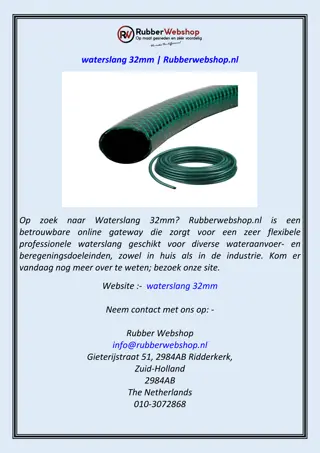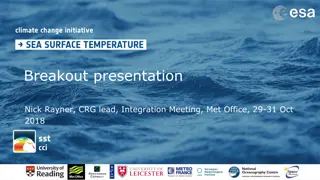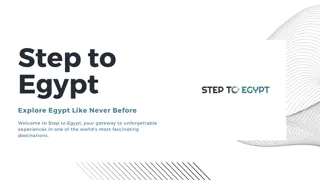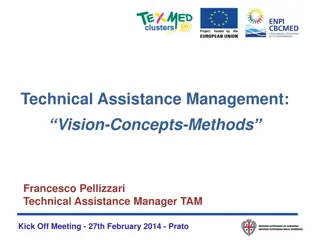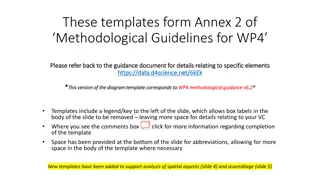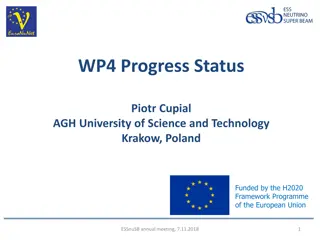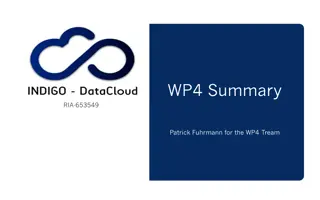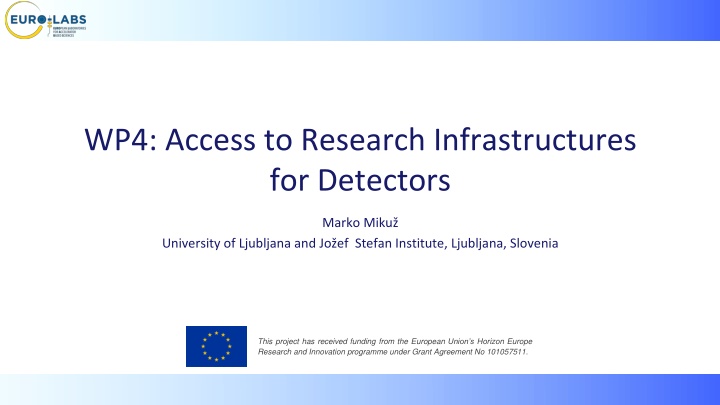
Detectors Research Infrastructures in European HEP Projects
Explore the role of WP4 in European High Energy Physics (HEP) projects focusing on detector research infrastructures. Learn about the current and future initiatives such as upgrades for HL-LHC, Higgs factory detectors, and proton-proton collider development. The article discusses important R&D phases, detector technologies, and the support provided by EURO-LABS WP4 for advancing detector capabilities in particle physics.
Download Presentation

Please find below an Image/Link to download the presentation.
The content on the website is provided AS IS for your information and personal use only. It may not be sold, licensed, or shared on other websites without obtaining consent from the author. If you encounter any issues during the download, it is possible that the publisher has removed the file from their server.
You are allowed to download the files provided on this website for personal or commercial use, subject to the condition that they are used lawfully. All files are the property of their respective owners.
The content on the website is provided AS IS for your information and personal use only. It may not be sold, licensed, or shared on other websites without obtaining consent from the author.
E N D
Presentation Transcript
WP4: Access to Research Infrastructures for Detectors Marko Miku University of Ljubljana and Jo ef Stefan Institute, Ljubljana, Slovenia This project has received funding from the European Union s Horizon Europe Research and Innovation programme under Grant Agreement No 101057511.
WP4:Access to RI for Detectors in EURO-LABS M.Miku :WP4. 2
Placing of WP4 in European HEP (present) Core HEP Detectors endeavour today - construction of upgraded detectors for operation at the HL-LHC In line with the stipulations of the 2013 European Strategy for Particle Physics (ESPP) report and their secondment in the 2020 ESPP update The successful completion of the high-luminosity upgrade of the machine and detectors should remain the focal point of European particle physics, together with continued innovation in experimental techniques. Associated detector R&D almost entirely finished, large orders placed, construction activities are well under way Expected load on WP4 - few remaining parts of late R&D, like LGAD and SiPM for the timing layers Main load driven by sensor QA activities to monitor production quality not serviced by EURO-LABS Exception to the grand picture - inner tracker part of ATLAS and CMS No solution found to survive the entire HL-LHC lifetime Replace the inner pixel detector at mid-point after ~2/ab of integrated luminosity Existing detector solution could serve as a viable replacement, but R&D for technologically more advanced detectors are being pursued vigorously LHCb - major upgrade in LS4 Radiation load to detectors - close to the inner parts of ATLAS&CMS trackers; the R&D in obvious need of EURO-LABS WP4 RI s. M.Miku : WP4 3
Placing of WP4 in European HEP (future) The 2020 ESPP establishes two project initiatives as high-priority the highest-priority next collider : an electron-positron Higgs factory for the longer term: a proton-proton collider at the highest achievable energy , dubbed as the FCC-hh project. Detector R&D for these two goals: supported by AIDAinnova EC project Other focal points: CERN RD collaborations, developments within (big) experiments Development cycle towards the use of a new technology in detectors spans over 10 to 20 years. prospective detector R&D ( Blue Sky research) TRL 1 guided detector R&D, according to known needs of future projects TRL 2-5 focussed detector R&D of approved experiments TRL 5-7 These detector development phases - supplemented by providing access to the RI s of EURO-LABS WP4 M.Miku : WP4 4
Placing of WP4 in European HEP (future) Major support of EURO-LABS WP4 for Higgs factory detectors Test Beams (WP4.1) and Detector Characterization (WP4.2) tasks Radiation load is relatively small Still testing at low levels of radiation & checking for single event effects Detector studies aimed at FCC-hh Detectors at FCC-hh - highest radiation levels (after 30/ab) forward calorimeters : 5000 MGy and 5x1018neq/cm2 innermost layer of the barrel vertex detectors ~1x1018neq/cm2 Need fluences in excess of at least 1x1017neq/cm2 benchmark for a yearly exchange of inner layers EURO-LABS WP4 intends to provide access to these conditions, even up to 1x1018neq/cm2 RI s in the Irradiations task WP4.3 End of 2021 the ECFA Detector R&D Roadmap was approved by the CERN Council Long term HEP Detector R&D goals defined Implementation strategy in terms of Detector R&D Collaborations (DRDC) worked out, starting in 2024 M.Miku : WP4 5
WP4 Budget Task name WP label EC + CH + UK EC Test Beams WP4.1 1,033,300 855,175 Detector Characterization WP4.2 236,420 236,420 Irradiations WP4.3 1,074,713 908263 Service Improvements WP4.4 740,675 606,800 Total Budget WP4 3,085,108 2,606,658 EC allocation 2.6 MEUR Supplemented by CH and UK contributions from their national funds About 40 % more TA funding than in AIDA2020 M.Miku : WP4 6
WP4.1-3 Deliverables Each RI delivers Access Units (~beam hours) to Projects with Users Two access modalities: physical/remote access Physical: users at RI (user support) Remote: users send samples to RI (handling, shipment) on each of the the tasks tomorrow ! Dedicated talks M.Miku : WP4 7
WP4.4 Service Improvements Aimed at improving access to RI for EURO-LABS Each RI proposed improvements with maximum impact on user access Improvements have to be ready in Y2 of the project EC contributions are matched by RI s own funding, typically exceeding EC Supplemented by WP4 (!) of AIDAinnova Dedicated talk on Service Improvementstomorrow ! M.Miku : WP4 8
How to Apply for TA in WP4? Single entry point through the EURO-LABS web page Generic review procedure in WP4: The scientific RI coordinator checks the technical requirements and eligibility of applications. Then the EURO-LABS WP4 User Selection Panel gets notified the application and decides on the allocation of resources. Some facilities require additional approval by their Scientific Committees (CERN, PSI ) e.g. CERN: The selection of users proceeds through the review procedure that is already in place at CERN: Requests for more than two weeks (one week) of beam time at the PS (SPS) have to be examined and recommended by the PS and SPS experiments committee ; those requests which concern R&D projects for the upgrade of LHC experiments are considered by the LHC experiments committee . Both are international committees composed of well-known experts in particle physics, they meet typically five times per year and report to the CERN Research Board . Shorter requests for beam time are usually easier to fulfil. They are examined, in accordance with the present CERN procedure, by the CERN PS and SPS physics coordinator . Where appropriate the requests are discussed with the DESY and PSI test beam coordinators and the EURO-LABS management. In all cases, the selected requests for test beam at the PS or SPS are sent to the USP for endorsement and allocation of EURO-LABS resources. Don t get frustrated, it s not as complicated as it sounds ! M.Miku :WP4. 9
WP4 Summary With WP4 EURO-LABS is providing transnational access to top level European Research Infrastructures for R&D on HEP detectors TA complement to AIDAinnova Acess to RI s free of charge Tailored to detector R&D where dedicated funding is often a problem Covers 3 types of research infrastructures, grouped into tasks Test Beams (3 facilities) Detector Characterization (2 facilities) Irradiations (6 facilities) Service Improvements at each RI to improve access Research Infrastructures ready to accept EURO-LABS users EURO-LABS WP4 shall facilitate Detector R&D in HEP during the next four years M.Miku :WP4. 10

